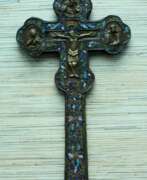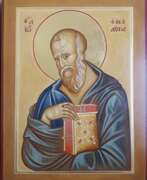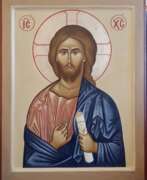Christian art

Christian art
Christian art as a genre is a rich and diverse field that has evolved significantly over centuries, mirroring the growth and changes in Christianity itself.
In the Byzantine Empire, Christian art developed an abstract aesthetic, diverging from the naturalism of Hellenistic art. This style was more focused on conveying religious meaning rather than realistic portrayals of subjects. Byzantine art's primary purpose was religious, employing geometric simplification of forms and reverse perspective to convey its messages (Wikipedia).
The Renaissance marked a significant phase in Christian art, characterized by an increase in monumental secular works alongside continued production of religious art. This period saw the creation of renowned masterpieces by artists like Leonardo da Vinci. The Reformation, led by figures like Martin Luther, brought about changes in the type of religious imagery displayed in churches, especially in Protestant regions. This era also witnessed a blending of religious and secular themes in art (Wikipedia).
In modern times, as secular notions of art gained prominence, ancient and medieval Christian art began to be valued more for art appreciation rather than strictly for worship. Modern artists like Marc Chagall and Salvador Dalí have produced significant works with Christian themes, influencing both sacred and secular arts. The development and distribution of religious art became more widespread with the advent of printing and the production of items like holy cards (Wikipedia).
Early Christian art, particularly in the western part of the Roman Empire, is considered a part of Paleo-Christian or primitive Christian art. This art form encompassed architecture, painting, and sculpture from Christianity's beginnings until about the early 6th century. The earliest Christian art included wall and ceiling paintings in the Roman catacombs, characterized by a sketchy style derived from Roman impressionism. Early Christian iconography was predominantly symbolic, using simple representations like the fish to convey Christian themes (Britannica).
The depiction of Christ's life in art was heavily influenced by the Feasts of the Church and the Nicene Creed. Popular works from devotional writers, such as the "Vita Christi" by Ludolph of Saxony, played a significant role in selecting scenes for illustration. Throughout different periods, the selection of scenes and the emphasis on certain aspects of Christ's life varied, reflecting the theological and cultural context of the time (Wikipedia).
For collectors, auctioneers, and experts in art and antiques, understanding the evolution and diversity of Christian art is crucial. It offers not just a visual representation of Christian theology and stories but also provides insight into the historical and cultural contexts in which these works were created.
If you're interested in exploring more about Christian art and staying informed about new acquisitions, auctions, and exhibitions in this genre, consider signing up for updates. Our subscription service focuses exclusively on Christian art, keeping you connected with the latest developments and opportunities in this rich artistic field.
| Country: | America, Europe |
|---|---|
| Start of the period: | III century |



